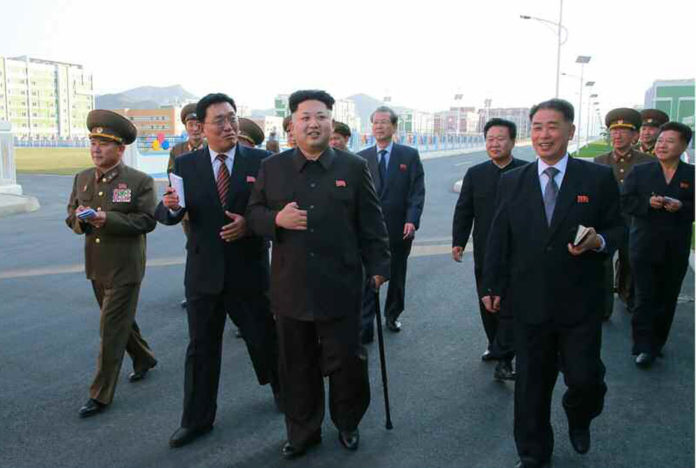
By Adam Cathcart, University of Leeds
After a month’s absence from public life, fuelling idle speculation about a possible coup, North Korean leader Kim Jong-un has at last reappeared in public. Limping with a cane, in line with reports he might be suffering from an illness such as gout, he inspected a residential complex for scientists and reportedly found it “very beautiful.”
And so North Korea seems almost back to business as usual. But the vacuum that Kim’s absence left, and the near-frenzy it stirred among observers of North Korea’s singularly opaque politics, is a reminder of just how powerful a symbol he has become.
Before the tears and snowfall that marked both his father’s funeral and his own de facto coronation in December 2011, Kim Jong-un didn’t command any real open deference. He was essentially just another official trailing around his father, the dying, sclerotic figurehead of the equally sclerotic North Korean state.
The younger Kim’s charisma was entirely second-hand; only by wearing the same coat and fur hat as his father on cold on-site inspections could he appear to approach Kim Jong-il’s authority. A handful of songs, operas, or split second moments in films alluded to the upcoming successor, but apart from occasionally standing on podiums next to his father (or a member of the Chinese Politburo sent to Pyongyang to size him up), he was very much a secondary figure.
But once his father died, Kim Jong-un exploded onto the scene in an almost Rabelaisian fashion. Once unleashed, he was a bundle of energy, wreathed in smiles, full of theatre, and highly animated at all times. He was clearly a man of great appetites, satisfying his cravings for louder music than the country’s youth had experienced before, for bigger amusement parks and skyscrapers, and for international attention.
Riding high
Surpassing the media magnetism of his father – whom the Western media long caricatured as “Dr Evil” – was no easy feat – but Kim Jong-un has succeeded by being constantly in the public eye.
Like a bull, he seemed eager to stamp his way out of the gates and toward the “strong and prosperous nation” that had been promised to the North Korean people in 2012. There was little time for mourning amid the vigour and renewed pomp on display by and with the young dictator.
Since then, Kim Jong-un has married a singer, started a family, launched an intercontinental ballistic missile, called for more production of mushrooms and turf, had a ski resort built, and ordered his uncle Jang Song-taek killed. With the exception of a few impoverished, ecologically decimated, and possibly rebellious provinces and border cities, he has been everywhere.
This meant that his recent disappearance left a massive void in the wide and nearly all-encompassing role which Kim Jong-un and his handlers had created for him in propaganda. And while rumours of a coup or house arrest can now be conclusively dismissed, the state media’s admission that Kim had been suffering “discomfort”, that he was limping in pain, and tacitly, that he could not be seen in public, was remarkable in itself.
Perception management
Given the awful bureaucratic stovepiping for which North Korea is famous, Kim’s absence from his standard schedule of “on-site inspections” may actually have had some negative economic impact.
When the leader goes to a factory tasked with producing women’s hosiery, he often leaves explaining the need for clearer supply chains, better choices in design and colour, and so on. In a system where corruption usually outpaces innovation, Kim’s visits can actually serve a positive function.
Likewise, while Kim’s endless visits to new apartment buildings or public works like pools or gardens (some call them “prestige projects”) are meant to show his care and build up his cult of personality, they also clearly indicate to various stakeholders that their contributions to the polity are valued, and that there is a future for them in this otherwise difficult state where even electric power cannot necessarily be depended upon.
But since North Korea’s government admits to almost nothing, and manages the leader’s appearances extremely scrupulously, keeping Kim out of public view during illness will have been paramount. Indeed, there is an almost clinical reverence for the body and person of the supreme leader (suryeong) in their system, dating back decades.
Although Kim’s father clearly declined in his later years, Kim Jong-il was extremely fastidious with appearances and regime choreography, and those practices left a deep imprint on the system. For Kim to appear in a wheelchair, or even immobilised in a seated position like Franklin Delano Roosevelt, could greatly diminish his prestige.
There is also plenty of precedent for a leader strategically avoiding the limelight. Kim Jong-il disappeared for several months in 2003 as the Iraq War was starting. He must’ve recalled how Kim Il-sung was nearly killed by American bombs in Kanggye in November 1950 – and surmised that the US is not monitoring movements inside North Korea for mere amusement.
Keep calm
The North Korean people, meanwhile, will surely have asked no public questions about where the leader perhaps may have been. The “news” in North Korea is already so full of commemorations for the deceased earlier Kims that the shift of emphasis away from Kim Jong-un will have been hardly noticeable.
In any case, people in the provinces are more interested in their food rations in the cold months ahead, and many do not have sufficient electricity to watch the broadcasts from Pyongyang that analysts outside of North Korea spend such time parsing.
State propaganda has long been explicitly linking Kim Jong-un together with his two dead predecessors anyway, meaning that the personality cult has become sufficiently conflated that the dead men can, in effect, hold the house down while their mutual successor and avatar recuperates from an operation (or whatever it was).
Today, the dead Kim Jong-il’s accouterments are on display in a monstrously expensive mausoleum in the heart of Pyongyang – a building which young North Korean soldiers and students must pledge to defend to the death in the ever-present possibility of a foreign invasion – while all North Koreans are expected to celebrate anniversaries of important speeches and appearances by these dead leaders on a daily or weekly basis.
Kim Jong-un, meanwhile, was advised or forced by necessity to step back for a time, allowing the symbols to project Kimist authority on his behalf.
Now, North Korean life is back to normal – somehow emphatically normal – and Kim is apparently back. A restless soul, he will probably soon dispense with his cane and make a full return to the public eye, more vigorous and cantankerous than ever.
![]()
Adam Cathcart does not work for, consult to, own shares in or receive funding from any company or organisation that would benefit from this article, and has no relevant affiliations.
This article was originally published on The Conversation.
Read the original article.




















